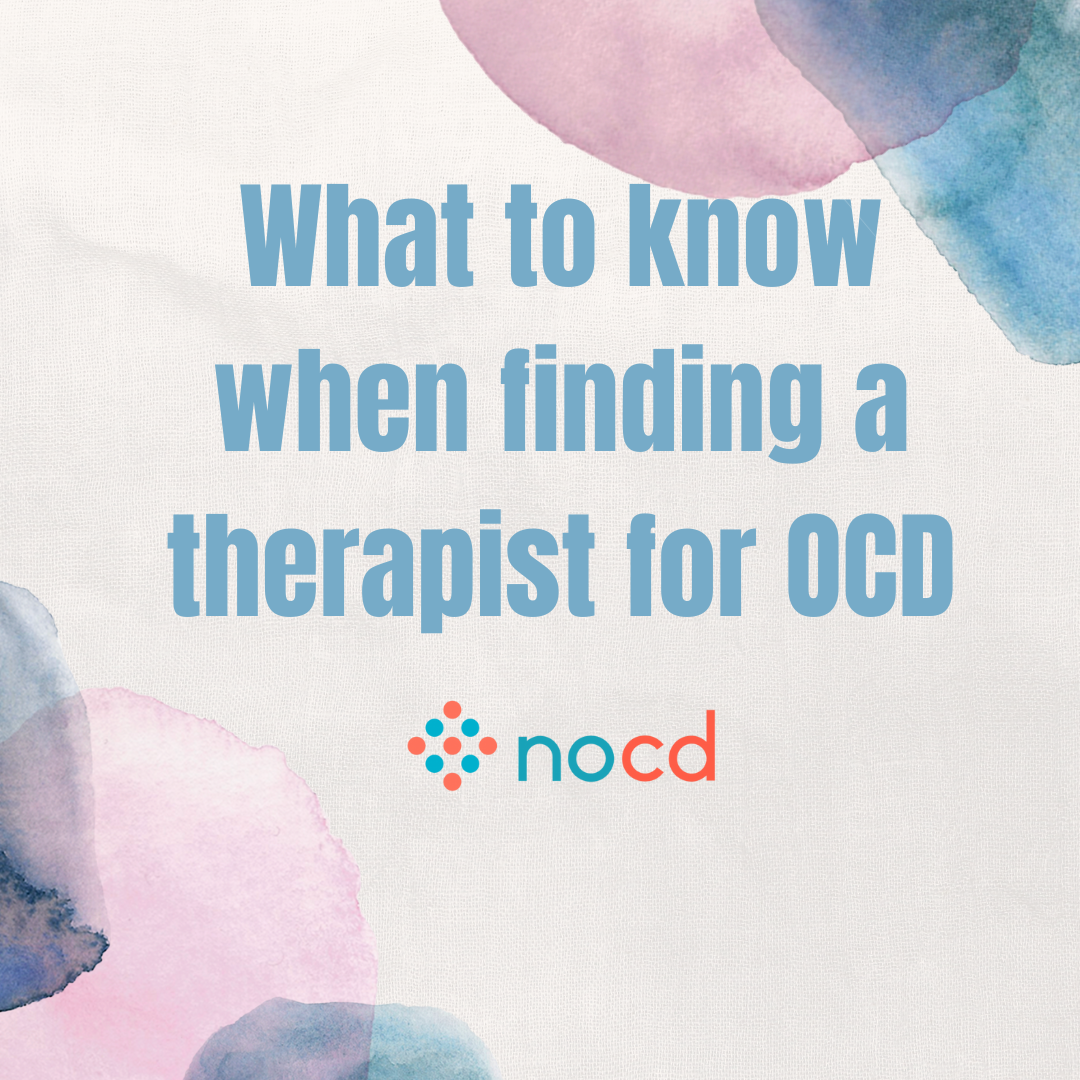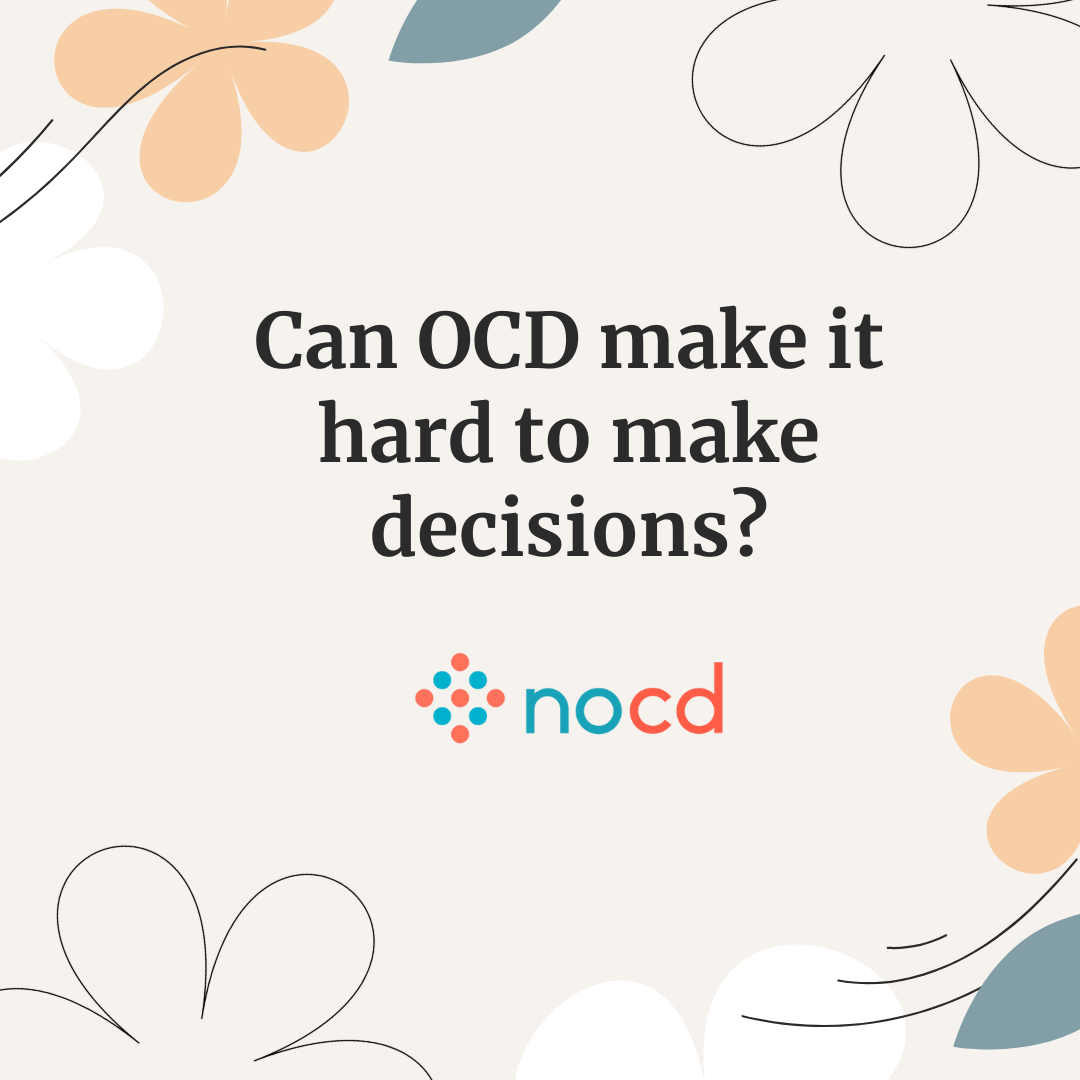Tardive dyskinesia is a movement disorder caused by the effects of some medications, primarily antipsychotics. The main symptoms are involuntary and repetitive facial and body movements. Symptoms most commonly occur for people with long-term antipsychotic use but can appear as early as 3 months after starting a medication.
Tardive Dyskinesia Is Often A Sign Of OCD
Many people with Tardive Dyskinesia also struggle with misdiagnosed OCD. The first step to getting help is an accurate clinical assessment and diagnosis. NOCD’s therapists will provide a comprehensive assessment of your experience. If they find that you do not meet the criteria for OCD, they will still help assist you in identifying what you may be experiencing. Get Started With A Free 15 Minute Call
What Is Tardive Dyskinesia?
Tardive dyskinesia is a drug-induced movement disorder. It is a potential side effect primarily of antipsychotic medications, and less commonly, other medications. These movements are involuntary (done without conscious control) and repetitive. The movements usually involve the lip, jaw, or tongue position during rest, swallowing, or speech.1
Tardive dyskinesia happens in up to half of patients that are on antipsychotics. Tardive dyskinesia usually presents after 1-2 years of long-term exposure to an antipsychotic but may occur as early as 3 months after starting a medication. In those older than age 60, tardive dyskinesia can present within 1 month. If patients are on an oral antipsychotic, symptoms may appear within 4 weeks of stopping the medication. If patients are on a long-acting injectable antipsychotic, symptoms may appear within 8 weeks of stopping. Symptoms gradually increase in severity and can hit maximum severity over a few weeks.
Symptoms of tardive dyskinesia may disappear within 1 month of discontinuing the antipsychotic. These symptoms are only considered tardive dyskinesia If symptoms persist for more than 1 month after discontinuing the offending antipsychotic.1
It’s important to talk with your prescriber or your pharmacist if you are taking medication and worried about tardive dyskinesia. They can help to tell you how likely it is you could experience it while taking or stopping the medication.
How Common Is Tardive Dyskinesia?
The first-generation “typical” antipsychotics have a higher risk of causing tardive dyskinesia compared to the second- or third-generation “atypical” antipsychotics. However, both typical and atypical antipsychotics can cause tardive dyskinesia.1
Tardive dyskinesia develops in about 20–50% of all patients treated with antipsychotics, but it varies among different age groups with prevalence increasing with older age. The incidence of antipsychotic-induced tardive dyskinesia is lower in younger individuals (3–5% per year) and higher in middle-aged and elderly patients, particularly women, reaching incidence rates as high as 30% after 1 year of exposure to neuroleptics. In atypical antipsychotics, the total annual incidence rate ranges from 0.8% in patients younger than 50 years to 5.3% in those older than 50 years.1
Both genders are equally susceptible to tardive dyskinesia, postmenopausal women might have a higher risk of developing the condition. In addition to age and gender, other factors that may increase the risk of tardive dyskinesia include the African-American race, pre-existing movement disorders, brain damage, cognitive impairment, total medication risk (dose and the duration of drug exposure), mood disorder, presence of negative schizophrenia symptoms, alcohol and drug abuse, and diabetes mellitus.1
Symptoms of Tardive Dyskinesia
Symptoms of tardive dyskinesia are rarely disabling and usually do not worsen once the symptoms are stabilized. Symptoms may persist for years or decades, even if the antipsychotic is discontinued. Movements are uncontrolled, which means symptoms can be at spontaneous moments during the day. There may be minor or major social embarrassment associated with tardive dyskinesia.1
Symptoms of tardive dyskinesia are not “triggered” by certain things, but certain medicines to treat mood disorders and other mental health problems may increase the risk for tardive dyskinesia. It is thought that caffeine may also play a role. Symptoms can get worse with increased stress and movements can also worsen with emotional arousal. However, symptoms can get better with increased relaxation and symptoms will disappear with sleep.1
Symptoms of Tardive dyskinesia include:1
- The most common tardive dyskinesia movement is facial involvement, including chewing, lip smacking, puckering, or pursing, tongue twisting, and facial grimacing.
- Limb involvement symptoms include flexing and extending thighs, foot tapping, “piano-playing” movements in fingers and toes, and hand rubbing.
- Trunk involvement symptoms include repetitive rocking and swaying body movements.
Causes and Risk Factors for Tardive Dyskinesia
Many of the medications associated with tardive dyskinesia are taken to treat schizophrenia and bipolar disorder. The exact cause of tardive dyskinesia is unknown. It may be related to dopamine receptor sensitivity, nerve cells losing function over time and eventually dying, or excess free radicals in the body (and not enough antioxidants to get rid of them). Abnormalities in the central nervous system transmitters like GABA, norepinephrine, and acetylcholine may also have an impact on tardive dyskinesia development.2
The higher the dose of antipsychotic or bipolar medication, the higher the risk of developing tardive dyskinesia. Similarly, the longer someone is on one of these medications, the higher the risk of developing tardive dyskinesia.2
Primary risk factors for developing tardive dyskinesia include:2
- Older age
- Female
- High medication doses and longer treatment periods (total exposure to neuroleptics)
- Symptoms may emerge or worsen following the reduction/discontinuation of dopamine receptor blockers agents (DRBA)
Other risk factors for developing tardive dyskinesia include:2
- African American race
- Pre-existing mood disorder
- Trouble remembering, learning new things, concentrating, or making decisions that affect their everyday life
- Delayed response, freezing mid-action, or inability to stay still
- Alcohol and/or substance abuse
- Use of lithium and anti-Parkinson medications together
- Pre-existing parkinsonism
- Pre-existing movement disorders
- Diabetes
- HIV infection
- Previous brain damage
- Genetic risk and presence of negative schizophrenia symptoms (lack of self-care, feeling disconnected, avoidant)
Antipsychotic Medications Linked With Tardive Dyskinesia
Typical antipsychotics may be more likely to cause tardive dyskinesia than atypical antipsychotics. Gastric motility agents and antiemetics, such as metoclopramide and prochlorperazine, can also cause the condition.1
These antipsychotic medications have a higher risk of causing tardive dyskinesia:1
- Haloperidol (Haldol) – first generation
- Clozapine (Clozaril/Versacloz) -first generation
- Risperidone (Perseris) – first generation
- Olanzapine (Zyprexa) – first generation
- Quetiapine (Seroquel) – first generation
These first-generation antipsychotics can also cause tardive dyskinesia:
- Loxapine (Loxitane)
- Asenapine (Secuado)
- Thiothixene (Navane)
- Trifluoperazine (Stelazine)
- Fluphenazine (Prolixin)
- Pimozide (Orap)
- Perphenazine (Trilafon, brand discontinued)
- Chlorpromazine (Thorazine)
- Thioridazine (Mellaril)
These second-generation antipsychotics can also cause tardive dyskinesia:
- Aripiprazole (Abilify)
- Paliperidone (Invega)
- Iloperidone (Fanapt)
- Ziprasidone (Geodon)
- Amisulpride (Barhemsys)
Antipsychotic medications have a risk of side effects, including serious side effects. You should talk with your healthcare professional about the benefits and risks of any medication before starting treatment.
Treatment For OCD NOCD: Online OCD Treatment Covered By Insurance – Regain your life from OCD. Do live video sessions with a licensed therapist specialized in treating OCD. Treatment from NOCD is covered by most major insurance plans. Learn how you can use your insurance benefits. Visit NOCD Talkiatry: Is OCD Medication Right For You? Speak with A Doctor – Talkiatry can match you with a psychiatrist who takes your insurance and is accepting new patients. They’re in-network with major insurers and offer medication management with supportive therapy. Free Assessment
Can Other Medications Cause Tardive Dyskinesia?
In addition to antipsychotics, tardive dyskinesia can also result from long-term exposure to other dopamine receptor blocking agents (DRBAs). Examples of DRBAs include tricyclic antidepressants, medications that treat vomiting and nausea, and other medications used for gastrointestinal disorders.1
There are also rare cases of movement disorders that are associated with the use of antidepressants, such as certain selective serotonin reuptake inhibitors (SSRIs) or selective serotonin norepinephrine reuptake inhibitors (SNRIs). Rare cases of tardive dyskinesia were also associated with lithium use. Calcium channel blockers, such as cinnarizine and flunarizine may also cause symptoms of tardive dyskinesia.1
Here are some other medications potentially linked with tardive dyskinesia:3
- Antidepressants: Tardive dyskinesia induced by antidepressants is less prevalent than when induced by antipsychotics, but can be more common in elderly patients taking antidepressants. Symptoms are worse with higher doses of antidepressants and also in those that have also taken lithium.
- Antiemetics for nausea & vomiting: Metoclopramide has a strong correlation with the occurrence of tardive dyskinesia, and reducing the dose of metoclopramide has not been shown to decrease the risk. Old age, female sex, history of diabetes, and taking metoclopramide for 12+ weeks are risk factors for developing metoclopramide-induced tardive dyskinesia
- Anti-seizure medications: Carbamazepine and lamotrigine are associated with this condition, but the incidence is rare. Phenytoin also has a well-documented link to tardive dyskinesia, most reported in children and young adults.
- Anti-allergy medications (antihistamines): Tardive dyskinesia has been reported in long-term use of antihistamines and antihistamine overdose. The condition can occur as soon as 7.5 months in those that use hydroxyzine
This is not a comprehensive list of medications that could cause tardive dyskinesia. If you have questions about a medication you are taking and the possibility of it causing tardive dyskinesia, you should talk with your prescriber.
Health Conditions Linked With Tardive Dyskinesia
Certain medicines to treat mood disorders and other mental health problems may increase the risk for tardive dyskinesia. If you have any of these conditions, make sure your care team is aware of your medical history.
Here are some conditions linked with tardive dyskinesia:
- Anxiety disorders
- Depression
- Obsessive-compulsive disorder (OCD)
- Schizophrenia
- Schizoaffective disorder
- Bipolar disorder
- Gastric motility disorders such as gastroparesis
- Nausea and vomiting
How Is Tardive Dyskinesia Diagnosed?
To be diagnosed with tardive dyskinesia, a person taking antipsychotic medication will be evaluated by their care team for symptoms. They will examine for abnormal involuntary movements before starting treatment and periodically during the treatment. The Abnormal Involuntary Movement Scale (AIMS) can be used to track the severity of symptoms over time.1,4
If someone has a history of receiving any of the medications with a high risk of tardive dyskinesia they exhibit involuntary movements of the face, limb, or trunk, the provider may suspect a tardive dyskinesia diagnosis. A diagnosis is only made if the symptoms have persisted for 1 month or longer after stopping the medication that caused it (except in the case of spontaneous tardive dyskinesia). The care team may also run additional tests to rule out other conditions with similar symptoms prior to making the tardive dyskinesia diagnosis. A few examples of conditions that may resemble this condition include Parkinson’s, Tourette’s, Huntington’s, Wilson’s, stroke, and tremors.1,4
A diagnosis of tardive dyskinesia is confirmed in patients with more than 3 months total time of antipsychotic medication exposure. In people older than 60 years of age, the time frame is more than 1 month. The criteria below must also be met.
Criteria for a tardive dyskinesia diagnosis include:1,4
- Moderate to severe abnormal movements in more than 1 body area
- Mild abnormal involuntary symptoms in more than 2 body areas
- No other cause is contributing to tardive dyskinesia symptoms
Physical Exam
Providers may complete a physical exam to learn more about the severity of the tardive dyskinesia symptoms. The first physical exam would be HEENT (head, eyes, ears, nose, throat). The assessment would look for involuntary tongue movements, chewing movements, lip smacking, and puckering. The provider may also assess the lungs to listen for significant humming or moaning. Extremities will be assessed for involuntary movements of the arms, legs, feet, and toes.1,5
The Abnormal Involuntary Movement Scale (AIMS) scale is a 12-item scored tool used by providers to detect tardive dyskinesia. The AIMS tool is also used to track the severity of symptoms over time in patients receiving medications that have the risk of causing tardive dyskinesia. The scale consists of 4 parts:1,5
- Face movements
- Arms, legs, and trunk movements
- Not having the ability or strength to perform specified acts or functions, also patients’ awareness of abnormal movements
- Dental status
Medical History
It is important that the provider knows about our complete medical history so that other conditions with similar symptoms to tardive dyskinesia may be ruled out. Looking at the differences between the other conditions and tardive dyskinesia will be helpful in determining if it is true tardive dyskinesia. Siblings of patients with schizophrenia are more prone to tardive dyskinesia. The provider may also check for alcohol and/or substance abuse, as these are possible risk factors for the condition.6
If you have any of these previous conditions, make sure the provider is aware of your history as they may increase the risk for tardive dyskinesia:6
- Symptoms involving the nervous system and excess body movements (such as akinesia and akathisia)
- Schizophrenia
- Mood disorders
- Cognitive disturbances
- Parkinsonism
- Movement disorders
- Diabetes
- HIV infection
- Brain damage
Here are some examples of conditions with similar symptoms as tardive dyskinesia:6
- Parkinson’s disease: This condition worsens with the combination of the medication levodopa and antipsychotics. This typically occurs within days to weeks of starting medication or increased dose
- Akathisia: Akathisia mainly affects the legs. The main difference from akathisia is that people with tardive dyskinesia don’t realize they’re moving and have facial movements are not affected.
- Dystonia: This condition could appear within hours to day and resolves following discontinuation of medication, also less likely to affect the torso area of the body.
- Tourette syndrome: Tics may be more distinguishable with earlier onset in childhood
- Huntington’s disease: Abnormal movements with Huntington’s disease are usually non-repetitive and pure facial movements are less common than in tardive dyskinesia
- Stroke: Post-stroke dyskinesias are rare, but may arise with any subtype.
- Hyperthyroidism: This condition rarely causes spasmodic involuntary movements of the limbs or facial muscles, but symptoms resolve following treatment.
- Tremors: A tremor is rhythmic in its movement, particularly around one joint. Dyskinesia is not only involuntary, but it’s also usually disordered movements and not rhythmic.
Online Treatment For Body Focused Repetitive Behaviors (BFRBS) NOCD Therapists are specialized in treating BFRBs. Many people struggle with both OCD and BFRBs. Working with a therapist who has specialized training in treating both conditions can help you get your life back.
Tardive Dyskinesia Treatments
There is no standard treatment protocol for tardive dyskinesia. Treatment is individualized based on the severity of symptoms and the risks and benefits are weighed with every treatment decision. A more conservative treatment approach is used for those with mild, non-disabling tardive dyskinesia.1
For active management of tardive dyskinesia, the provider will likely have the steps below in the treatment process:1
- Discontinue the medication that caused the tardive dyskinesia and slowly decrease the dose to prevent worsened symptoms.
- If previously on a typical antipsychotic, consider switching to an atypical antipsychotic (listed above).
- Add a medication that would deplete the dopamine chemical in the brain such as Ingrezza, an FDA-approved treatment of tardive dyskinesia in adults.
- Deep brain stimulation for severe cases that don’t respond to medication treatment.
Adjusting Medication or Dosage
It may be beneficial to switch to an atypical antipsychotic to treat or decrease the symptom severity of tardive dyskinesia. Atypical antipsychotics, however, have additional side effects, including extreme drowsiness, weight gain, diabetes, and decreased ability to fight infection. The risks and benefits should be considered for each patient on an individual basis.2
The main aspect of tardive dyskinesia treatment is discontinuing the causative drug whenever possible, but a decrease in dose is recommended as sudden withdrawal is more likely to make symptoms worse. The sooner the offending medication is discontinued, the more likely it is that the condition will gradually resolve. If a patient requires continuous treatment with antipsychotics, the newer generation of “atypical” antipsychotics, such as quetiapine and clozapine, may be useful alternatives, though both typical and atypical antipsychotics have a risk for causing tardive dyskinesia.1
Treating Symptoms With Another Medication
In addition to discontinuing the offending medication that caused tardive dyskinesia, other medications may help reduce symptoms of tardive dyskinesia. Ingrezza significantly helps the condition in participants with underlying schizophrenia, schizoaffective disorder, or mood disorder.
Here are some medications used to treat symptoms of tardive dyskinesia:
- Deutetrabenazine (Austedo): Austedo is used to treat symptoms of movement disorders, such as involuntary movements of the face, tongue, or other body parts7
- Tetrabenazine (Xenazine): Xenazine is a first-line treatment for patients with severe, disabling tardive dyskinesia. 1
- Valbenazine (Ingrezza): Ingrezza is FDA-approved for the treatment of tardive dyskinesia in adults, improving symptoms while being generally well tolerated.8
- Clonazepam (Klonopin): Klonopin is effective in reducing abnormal movements, with 40-50% of patients reporting some improvement 2
- Amantadine (Gocovri): Gocovri is an antiparkinson drug that has been shown to lower AIMS scores and improve the severity of tardive dyskinesia movements. 9
- Antioxidants: For people with certain conditions, Ginkgo biloba, melatonin, and vitamin B6 may reduce symptoms of tardive dyskinesia.2,10
Can Tardive Dyskinesia Be Prevented?
Keep in mind that tardive dyskinesia is easier to prevent than it is to treat. If you have some risk factors for tardive dyskinesia, ask the care team about the risks and benefits of starting therapy with an antipsychotic. Be sure to start at the lowest effective dose and do not increase if not necessary. It is important to monitor for the symptoms of tardive dyskinesia and prevent long-term use of this medication if possible. If an antipsychotic is recommended, an atypical (second-generation) antipsychotic is preferred to reduce the risk of tardive dyskinesia.1,2
Be sure the provider examines you for any abnormal involuntary movements before beginning treatment. If possible, evaluate weekly for at least 2 weeks after starting treatment and when increasing to a new dose. For high-risk patients, evaluation is every 3 months while on typical antipsychotics and every 6 months while on atypical antipsychotics. For low-risk patients, evaluation is done every 6 months while on a typical antipsychotic and every 12 months while on atypical antipsychotics.1,2
Questions to Ask Your Healthcare Provider About Tardive Dyskinesia
If you are prescribed typical or atypical antipsychotics, keep the symptoms of tardive dyskinesia in mind when monitoring your own symptoms. The longer you are on one of these medications, the more common the tardive dyskinesia symptoms.
Questions to ask your care team about tardive dyskinesia may include:
- What helps calm tardive dyskinesia?
- Does tardive dyskinesia ever go away?
- Am I at risk for more severe symptoms if I am already taking medication for anxiety, depression, or other mental health conditions?
- How long does tardive dyskinesia usually last?
- Does tardive dyskinesia get worse at night?
- What is the best dosage to ensure fewer side effects?
- When should I reach out to you if I think I may have symptoms of tardive dyskinesia, or if my symptoms get worse?
- Is there anything I should tell my therapist about tardive dyskinesia?
In My Experience
In my experience, the treatment options for tardive dyskinesia are limited and the benefits of medications need to be weighed against their possible side effects. Children appear to be at greater risk of repetitive, involuntary facial movements, and the use of second-generation or atypical antipsychotics is increasing in children to decrease the risks of tardive dyskinesia.
If you notice the involuntary movement symptoms of tardive dyskinesia, please be sure to discuss your medical history and family history with your care team so they have all the essential information to provide you with the best treatment options. Reminder, alcohol abuse has been identified as a potential risk factor for the development of tardive dyskinesia. SAMHSA’s National Helpline is a free, confidential, 24/7, 365-day-a-year treatment referral and information service (in English and Spanish) for individuals and families facing mental and/or substance use disorders (1-800-662-HELP).
Treatment of tardive dyskinesia in patients is very complex and needs to be individualized for each patient. Unfortunately, the most effective drugs for treating the condition may have side effects that patients are unable to tolerate long-term. Providers should use the lowest, most effective dose of antipsychotic drugs, especially in the elderly and there should be regular follow-up for early detection of tardive dyskinesia. For severe tardive dyskinesia, tetrabenazine is the most effective treatment option but does have side effects.
To help our readers take the next step in their mental health journey, Choosing Therapy has partnered with leaders in mental health and wellness. Choosing Therapy is compensated for marketing by the companies included below. OCD Therapy NOCD: Effective, Affordable, & Convenient OCD Therapy Do live, face-to-face video sessions with a therapist who specializes in treating OCD and get 24/7 support between sessions. NOCD is covered by many insurance plans and is available nationwide. Visit NOCD Virtual Psychiatry Talkiatry Get help from a real doctor who takes your insurance. Talkiatry offers medication management and online visits with expert psychiatrists. Take the online assessment and have your first appointment in days. Free Assessment OCD Community - Free To Join! OCD Newsletter A free newsletter from Choosing Therapy for those impacted by OCD. Get helpful tips and the latest information. Sign-UpAdditional Resources
For Further Reading
- National Organization for Tardive Dyskinesia
- Discover Tardive Dyskinesia Resources & Support
- Tardive Dyskinesia and Movement Condition Support Group
- Test Your Tardive Dyskinesia Knowledge: Myth vs Fact
- Tardive Dyskinesia Care Partner Support Tips
- Hydroxyzine Vs Xanax for Anxiety: How Do They Compare?
What to know when finding a therapist for OCD With so much information out there regarding providers and treatment options for obsessive compulsive disorder, it can be hard to know exactly where to start—especially when you have to consider everything from the type of provider to the different treatment methods, as well as how you’ll fit it into your busy schedule. Can OCD make it hard to make decisions? From choosing what to wear in the morning to picking what to eat for dinner, decision-making is a part of everyone’s daily routine. But for millions of people with Obsessive-Compulsive Disorder (OCD), making any choice can feel like a daunting, sometimes impossible task.








